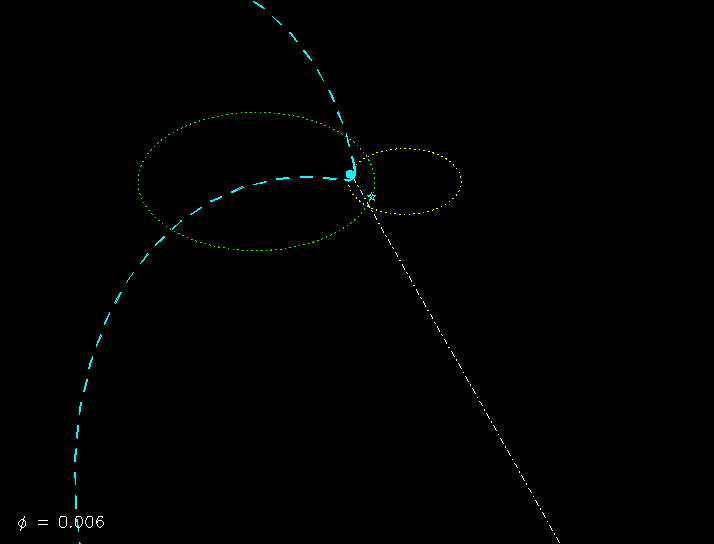| Colliding-wind binaries |
| WR140 Introduction |
| Episodic dust-makers |
| WR140 radio variation |
| Massive Stars Web site |

| P (d) | 2885 ± 73 | (2900)* | 2893 | (2900)* | 2899.0 ± 1.3 | 2896.5 ± 0.7 |
| e | 0.7 ± 0.05 | 0.84 ± 0.04 | 0.85 ± 0.01 | 0.87 ± 0.05 | 0.881 ± 0.007 | 0.8962 ± 0.0014 |
| ω (°) | 42 ± 10 | 32 ± 8 (abs) | 40.8 ± 3.1 | 31 ± 9 | 46.7 ± 1.6 | 44.6 ± 1.1 |
| T0 (JD) | 2423069±35 | 2446160±29 | 2449036±4 | 2448956±117 | 2446147.4±3.7 | 2446156.2±2.2 |
| To (Y) | 1922.04 | 1985.26 | 1993.13 | 1992.92 | 1985.22 | 1985.25 |
| KO5 km/s | 22 ± 3 | 28 ± 3 | 33.8 ± 1.5 | 25 ± 15 | 30.5 ± 1.9 | 30.9 ± 0.6 |
| KWC7 km/s | -40 ± 17 | -79 ± 50 | -91.3 ± 4.8 | -- | -82.0 ± 2.3 | -75.5 ± 0.7 |
| data | optical, 1922-85 | optical, 1922-85 | optical, 1980-93 | UV, 1985-95 | 1922-2002 + UV | Ref [5] + 2007-2009 |
| ref | [3] | [4] | [5] | [6] | [7] | [10] |
* The 2900-d period in these solutions was adopted from the infrared light curves
Fully defined orbit in three dimensions
From high-resolution imaging of the radio emission between phases 0.74 and 0.97,
Dougherty et al. [8] demonstrated that the WR 140 system rotates
clockwise on the sky, and derived an orbital inclination, i = 122±5°.
The binary itself was resolved by Monnier et al. (2004) [9],
who measured the stellar separation and position angle at phase 0.297.
Using this and the inclination, Dougherty et al. determined the longitude of
ascending node (Ω = 353±3°), completing the description of the orbit.
Further high resolution observations by Monnier et al. (2011) [9]
allowed derivation of an astrometric orbit which, combined with the RV observations,
yield the definitive orbit below, together with a distance of 1.67±0.03 kpc
and masses of 14.9±0.5 M☉ and
35.9±1.3 M☉ for the WC7 and O5 stars respectively.
| P (days) | e | ω (°) | T0 (JD) | Ω (°) | i (°) |
| 2896.35 ± 0.20 | 0.8964 +0.0004-0.0007 | 46.8 ± 0.4 | 2446155.3 ± 0.8 | 353.6 ± 0.4 | 119.6 ± 0.5 |
| References: |
| rev: 2 October 2015 Peredur Williams |
[2] P.M. Williams et al. in: H.J.G.L.M. Lamers & C.W.H. de Loore (Eds), Instabilities in luminous early type stars (Dordrecht, D. Reidel) 1987, p. 221-226.
[3] A.F.J. Moffat et al. ApJ 312, 807, 1987.
[4] P.M. Williams et al. MNRAS 243, 662, 1990
[5] K. Annuk in IAU Symposium No. 163, p. 231, 1994
[6] D.Y.A. Setia Gunawan et al. A&A 376, 460, 2001
[7] S.V Marchenko et al. ApJ 596, 1295,2003.
[8] S.M. Dougherty et al. ApJ 623, 447, 2005.
[9] J.D. Monnier et al. ApJ 602, 57L, 2004.
[10] R. Fahed et al. MNRAS 418, 2, 2011.
[11] J.D. Monnier et al. ApJ 742, 1L, 2011.